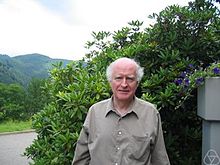John N. Mather
John N. Mather | |
|---|---|
 | |
| Born | John Norman Mather June 9, 1942 |
| Died | January 28, 2017 (aged 74) |
| Nationality | |
| Alma mater | Harvard University Princeton University |
| Known for | Smooth functions Topologically stratified space Aubry-Mather theory Mather theory |
| Awards | John J. Carty Award for the Advancement of Science (1978) National Order of Scientific Merit (Brazil) (2000) George David Birkhoff Prize (2003) Brouwer Medal (2014) |
| Scientific career | |
| Fields | Mathematics |
| Institutions | IHES Harvard University Princeton University |
| Doctoral advisor | John Milnor |
| Doctoral students | Giovanni Forni Vadim Kaloshin |
John Norman Mather (June 9, 1942 – January 28, 2017) was a mathematician at Princeton University known for his work on singularity theory and Hamiltonian dynamics. He was descended from Atherton Mather (1663-1734), a cousin of Cotton Mather.[1]
His early work dealt with the stability of smooth mappings between smooth manifolds of dimensions n (for the source manifold N) and p (for the target manifold P). He determined the precise dimensions (n,p) for which smooth mappings are stable with respect to smooth equivalence by diffeomorphisms of the source and target (i.e. infinitely differentiable coordinate changes).
He also proved the conjecture of the French topologist René Thom that under topological equivalence smooth mappings are generically stable: the subset of the space of smooth mappings between two smooth manifolds consisting of the topologically stable mappings is a dense subset in the smooth Whitney topology. His notes on the topic of topological stability are still a standard reference on the topic of topologically stratified spaces.[citation needed]
Since 1970s, he switched to the field of dynamical systems. He made the following main contributions to dynamical systems that deeply influenced the field.
1. He introduced the concept of Mather spectrum and gave a characterization of Anosov diffeomorphisms [2].
2. Jointly with McGehee, he gave an example of collinear four-body problem which has initial conditions leading to solutions that blow up in finite time. This was the first result that made the Painleve conjecture plausible [3].
3. He developed a variational theory for the globally action minimizing orbits for twist maps (convex Hamiltonian systems of two degrees of freedom), along the line of the work of G. D. Birkhoff, Morse, Hedlund, et al. This theory is now known as the Aubry-Mather theory [4][5].
4. He developed the Aubry-Mather theory to the higher dimensional case which is now called the Mather theory[6][7]. This theory turned out to be deeply related to the viscosity solution theory of Crandall, Lions and Ishii et al for Hamilton-Jacobi equation. The link was revealed in the weak KAM theory of A. Fathi [8].
5. He has been engaged in the problem of Arnold diffusion. In 2001 he made an announcement claiming a proof of Arnold diffusion for Hamiltonian systems of three degrees of freedom[9][10]. However, he was not able to give a proof until his death, though he made some important progress[11]. The first complete and published proof of this problem is due to C.-Q. Cheng [12]. In the proof, Mather theory serves as the basic tool.
He was one of the three editors of the PRINCETON MATH series in Annals of Mathematics Studies.
He was a member of the National Academy of Sciences beginning in 1988. He received the John J. Carty Award of the National Academy of Sciences in 1978 (for pure mathematics)[13] and the George David Birkhoff Prize in Applied Mathematics in 2003. He also received the Brazilian Order of Scientific Merit in 2000 and in 2014 the Brouwer Medal from the Royal Dutch Mathematical Society.
See also
References
- ^ http://www.werelate.org/wiki/Person:Atherton_Mather_%281%29
- ^ Mather, John N. "Characterization of Anosov diffeomorphisms." Indagationes Mathematicae (Proceedings). Vol. 71. North-Holland, 1968.
- ^ Mather, J. N., and Richard McGehee. "Solutions of the collinear four body problem which become unbounded in finite time." Dynamical systems, theory and applications. Springer Berlin Heidelberg, 1975. 573-597.
- ^ Mather, John, and Giovanni Forni. "Action minimizing orbits in hamiltomian systems." Transition to chaos in classical and quantum mechanics (1994): 92-186.
- ^ Bangert, Victor. "Mather sets for twist maps and geodesics on tori." Dynamics reported. Vieweg+ Teubner Verlag, 1988. 1-56.
- ^ Mather, John N. "Action minimizing invariant measures for positive definite Lagrangian systems." Mathematische Zeitschrift 207.1 (1991): 169-207.
- ^ Mather, John N. "Variational construction of connecting orbits." Annales de l'institut Fourier. Vol. 43. No. 5. 1993.
- ^ Fathi, Albert. "Weak KAM theorem in Lagrangian dynamics preliminary version number 10." by CUP (2008).
- ^ Mather, John N. "Arnold diffusion. I: Announcement of results." Journal of Mathematical Sciences 124.5 (2004): 5275-5289.
- ^ Mather, John N. "Arnold diffusion by variational methods." Essays in Mathematics and its Applications. Springer Berlin Heidelberg, 2012. 271-285.
- ^ Mather, John N. "Shortest curves associated to a degenerate Jacobi metric on T2." Progress in variational methods 7 (2010): 126.
- ^ Chong-Qing Cheng, "Dynamics around the double resonance", Cambridge Journal of Mathematics, Volume 5 (2017), Number 2, Pages: 153 – 228
- ^ "John J. Carty Award for the Advancement of Science". Archived from the original on 2015-02-28.
{{cite web}}: Unknown parameter|deadurl=ignored (|url-status=suggested) (help)
External links
- Mather notes on Topological Stability (on the Princeton University website, pdf file)
- John Mather bibliography on the Princeton University website (pdf file)
- John N. Mather at the Mathematics Genealogy Project
- Death announcement on the Princeton University Mathematics Department website
- 1942 births
- 2017 deaths
- Members of the United States National Academy of Sciences
- 20th-century American mathematicians
- 21st-century American mathematicians
- Princeton University faculty
- National Academy of Sciences laureates
- Recipients of the Great Cross of the National Order of Scientific Merit (Brazil)
- Guggenheim Fellows
- Brouwer Medalists
- Harvard University alumni
- Princeton University alumni
- Institute for Advanced Study visiting scholars
- Dynamical systems theorists
